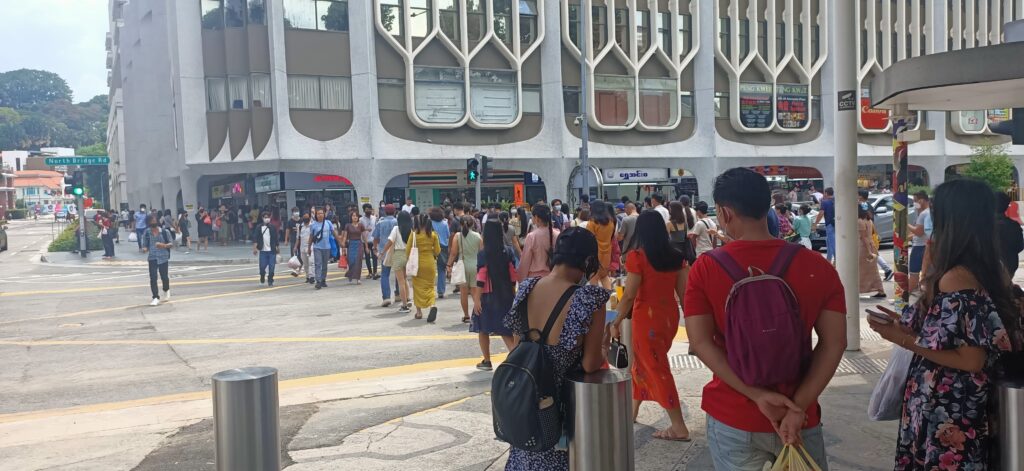This is the fourth in our series of blogposts in relation to the Budhan podcast project, a community led initiative that has sought to capture the experiences of some of the most marginalised communities in India during the COVID19 pandemic.
In the previous blogposts we reflected primarily on Season 1 of our series, at a community speaking of, sometimes enacting their own experience of pain, and at the key role of the aesthetic in offering glimpses of that which cannot be spoken – through hyper-real and melodramatic performances. As an attempt by members of the Chhara DNT community to make sense of its own experience, and bolster its response to the pandemic, a primary audience for Season 1 had been somehow internal. Taking Season 2 as our focus, in this post we consider the challenges of a marginalised group speaking of the plight of other marginalised groups, as artists step out of the community to document the experiences of other DNT groups. We look at how that which could not be spoken becomes expressed through the political voice as marginalised communities make claims (to resources, equality, visibility) in the context of the pandemic.
Materiality of a season
The material conditions of production of season 2 differ substantially from season 1. In season 2, we have a team with greater technical expertise, having worked on ten episodes in lockdown conditions, and now supported by more substantial funding and professional equipment. The actors who had enacted plays, songs and monologues are now standing behind the camera, as directors in their own right. Although theatre performances continue being used, there is a clearer shift towards the realist documentary form – a shift that goes alongside the reimagination of the audience. If in the early episodes the audience was most explicitly the Chhara community itself, and the subject and the audience intermingled in ways that unsettled the mode of audienceship, in Season 2, the subject is more clearly demarcated. The audience is equally sequestered outside of the frame – if not an ‘outside gaze’, in a simple sense, the audience is seated outside the process of the film. The films, in other words are not speaking ‘to one‘s own’, but rather to an abstract audience constituted of diverse positionalities. The narrative voice (whether of the anchor, or of Budhan Theatre (BT) and other performers who take on the role of the anchor in some episodes) is also one that is familiar to the documentary form – the audience is being introduced to the community, their history and struggles. As such, even though the films continued to be made by indigenous film makers, this was a gaze of members of one marginalised community onto others.
We are now also at a different point in the unfolding of the pandemic. Most of the shooting that features in season 2 was done after the first wave of the pandemic had subsided and when it became possible to move out of the confines of closed spaces and neighbourhoods. A lot of the footage is outdoors, in streets, in neighbourhoods and in temporary settlements of nomadic communities. By the time we arrived at the stage of editing, however, India was thrown deep into the devastating second wave of the Delta variant, when the country faced a shortfall of oxygen, vaccines, medicines and wood to burn the dead. In such a situation it was neither possible to base the films simply on the footage already collected, nor was it possible to return to the field. What we have then is the juxtaposition of footage, of interviews and performances shot ‘between waves’, and online interviews carried out as the second wave unfurled. A creative response to this situation can be seen in episode 7 based on the experiences of the Pardhi community in Maharashtra, wherein montages of still photographs are juxtaposed with videos of online interviews, where the smart phone is included in the frame to make the materiality of production visible.
The Political Voice
Episodes of season 2 articulate an explicit political voice. There are clear demands being made, which are easier for the audience to identify. The actors, and the interviewees are composed, their speech is political, their words well-chosen and addressed outwards – the interviewee looking straight into the camera. In the episodes, we hear about a shift to begging, which as an activity further criminalises the community, putting lives and livelihoods at risk, and that this labour falls entirely on women. We learn about the deepening educational gap given by digital education, about living in poverty, about evictions and resettlements, about (lack of) livelihood and the overall exclusion of these communities from the mechanisms through which humanitarian support was extended by state and civil society alike. These issues are all being articulated as demands rather than laments or complaints with a recognisable aesthetics. We point here to the specificity of the unambiguity of a political voice that makes explicit demands, laying out frameworks of (in)justice and demanding the interlocution of the state. Perhaps it is the case that by this time the dust had settled on the extent of suffering brought about by the neglect of the state in enforcing a lockdown without warning or preparation (see in particular the episode ‘We wanted to go back’, focussed on the suffering of the millions of ‘migrant workers’ who walked thousands of kilometres to get home), the spectacular inefficiency of the state in preparing for the second wave, the extent of death and suffering this caused, and the continuities between this violence and the long history of social and political abjection.
The political voice of the podcast is diverse in its articulation, and the aesthetic difference between its forms is instructive of the complexity of the DNT political subject. The clearest political demands are made from the chair. There are plastic chairs where interviewees sit – chairs placed outside of households, where interviewees sit holding onto their arms, projecting their voices with clarity. The chair is a key symbol of authority, especially in rural India and in poor urban settings, where entire settlements may only have one chair available that is shared for important guests. Elevated from the floor, sitting on a chair also means not sitting on dirt, and is as such loaded with the political connotations of hierarchy and pollution. Demands made from the chair, with a few exceptions, are articulated by men.
Other voices, largely those of women, speak instead from the floor: sitting or squatting on the mud floors of their kitchens, and sometimes on charopais, the woven beds where entire families sleep in the open. Their demands from the floor are more like laments: ‘what can we do sir’, some conclude, addressing the interviewer behind the camera. Their apparent helplessness should however not be mistaken with passivity. In fact, if there is a resignation to one’s condition of abject poverty, a resignation that it will not change, there is also a resolution to do what it takes to survive. During the pandemic, many of the women we see ran entire households on their own, defying lockdown restrictions to beg. If the men made demands from chairs and women laments from the floor, women were the one who actively defied authority as men had to take on more passive roles (for being more easy targets of police retaliation, but also out of a sense of entitlement to ‘better’ work i.e. they would not take up household chores). From the floor, women’s voices conform to societal expectations (reproduced within communities) of a certain passivity attached to their behaviour, that same ‘passivity’ that allows them more easily than men to circumvent the law, even as this exacerbates the risk of social and sexual violence (Episode 4 features archived footage of a mob lynching of a Madari woman accused of ‘child lifting’ and an account of the gang rape and murder of another, for instance). Spoken as monologues (from the chair or the floor), these speeches have what Bakhtin calls the quality of the dialogue – they are addressed to one and in fact multiple audiences. At one level they are addressed to the immediate listener, a member of BT behind the camera asking questions – who, for many of the communities, is also seen as a patron (with political and humanitarian connections). At another level they are addressed to a more abstract authority of the state. This distinction between the chair voice and the floor voice also speaks to the relationship between the signifying voice and vocality outside referential meaning (Weidman 2014), and of the gendered differentiation in the aesthetic deployments of the political voice.
Performance as Ethnographic Layer
The articulation of a political voice reconfigures the function of other elements of the podcast assemblage. As an instance here we focus on the role of theatrical performance. As compared to the role of sublimation, enabling a glimpse of ‘that which cannot be spoken’, performances here play a very different role – that of re-enacting through hyper-realisation. The first episode of the season focussed on the Bahurupia community of itinerant performers demonstrates this well. The episode features two performances: the first is drawn from the community’s own traditional repertoire, while the second is a performance by one of BT’s lead actors, Ruchika Kodekar. The interview of a Bahurupia community leader and actor, talking about the vanishing art of the community, and the abuses they endure, is intercut with scenes of their community performances enacted for the camera, of (male) actors dressed like monkeys, gurus or women performing characters from modern Hindu epics. This is a stunning interview and framing, with the camera moving between the lead actor wearing full makeup, a side actor who speaks in all seriousness with a bloody eye drawn over a white foundation, and the scene of the performance itself. These scenes from the community are then themselves intercut with Ruchika’s performance, dressed up as Kali Mata (with a blue face, her tongue sticking out, a nose ring and nose chain) performing in the middle of Chharanagar, paraphrasing, offering back to both the community and the viewer another version of the interview:
I am mother
And I am hungry,
My children are also hungry,
My husband (gharwala) is also hungry
Hunger and struggle have very old connections
Ruchika’s performance is intercut with interviews from the community now focussed on the experience of women who, during the pandemic, bore the brunt of earning livelihood for the whole community by begging, subjecting themselves to police violence and the risk of infection. A pregnant woman tells of how she went begging when nine months pregnant, walking for miles, and how she was beaten up by the police. As she recounts her story, Kali Mata echoes it, returning to the public these experiences:
When the pandemic came everything stopped,
There was no work
And no grains of food to eat
I was pregnant at the time
I was hungry
And with me, my children were hungry too
When I asked for food, then I received sticks
After falling down, I had to go back
You entertain yourself with TV and mobile phones
But I am born artist
Yes, a born artist
Which you call Bahurupia
I feed my family by showing my art
But today I am receiving sticks instead of food.
Kali Mata’s performance is filmed in slow motion, with a focus on the actress’ blue face, her facial expressions, her tongue sticking out. At times, when the camera moves back it reveals a small audience around her, gathered from the street where the act is being filmed. The slow-motion choice, (which was in fact the fixing of a technical glitch in which voice and images failed to sync), lends this piece a grave and dramatic style supported by a suspense-kind of background music. The image and words of the deity embodied are in themselves ponderous, as though the cosmic, the mythological had manifested in the mundane. It is beautiful, grotesque, and evokes the terrifying power of the Mother’s justice. The uncanny presence of a street audience, of the everyday, at the corner of the frame makes them all the more so.
In the case of both performances, we see the creative use of intercutting as a technique, a to and fro movement between temporalities in such a way as to create contiguity, meaning and affect within each temporality and beyond their sum. The intercut here produces a rich ethnographic layer, which picks up, reinterprets, transforms and hyper-realises the political voice, setting the stage for the revolutionary voice. It is important here to recognise that this technique lies in continuity with a longer tradition in BT’s theatre practice, which takes real-life stories and re-enacts them both to communities and to power: for communities in order to heal shared experiences of pain and create a movement; to power in order to make claims but also to achieve redemption. The interpretative work of BT theatre is made evident, there is a real that the hyper-real performances directly refer to. In film, through the intercut, these are made adjacent, enmeshed in each other.
The Revolutionary Voice
In the initial episodes of season 2 the documentary form is prevalent and the political voice – although augmented via performances – remains composed. As we move through the series, through the peak of the pandemic in India, we also see a shift from a more respectable voice to an unruly one (khanna 2012, Shankland et al 2011) – one that, paying witness to the sheer dispossession of the participants eventually, calls for a revolution. In episode 9, focussed on one of the most deprived Muslim-DNT communities that we encounter in the series, we are thrown back to the often-appearing theme of the threshold between animal and human. “They treat us like animals”, so the episode is called – a line repeated by different interviewees, alongside descriptions of chronic hunger, backbreaking work and a life confined to the most abject poverty with no possibility of redemption for oneself or the next generation. “Our children are not very smart”, the woman seated on the mud floor of her house declares, having grown up with food for two days out of four. “We have to live under this oppression”. Instead of echoing and augmenting the resigned voices of interviewees through performance, performers intercut their speech with a parallel dialogue calling on those who care to overrule the powerful.
“Those who care about the weak should speak,
We should change the world
It should scream
It should feel that those fighting hunger won’t get tired
The fire in the belly gets into the head
If some food goes into their belly, then there will be victory”
There is a shift in tone and addressivity (Bakhtin). If in the performance of Episode one the actress speaks in the first person as the interviewee, here actors address the audience head on. “Would you not get food and stay quiet? One must speak up”. They speak here almost to a ‘superaddressee’, that third person other than the speaker and the listener who listens sympathetically and understands justly.
References
Bakhtin, Michael. 1981. The Dialogic Imagination. M. Holquist (ed.), Austin: University of Texas Press.
Khanna, A. Seeing Citizen Action through an ‘Unruly’ Lens. Development 55, 162–172 (2012).
Khanna, akshay. 2012. Seeing Citizen Action through an ‘Unruly’ Lens. Development 55, 162–172.
Shankland, Alex, Danny Burns, Naomi Hossain, Akshay Khanna, Patta Scott-Villiers and Mariz Tadros. 2011. Unruly Politics: A manifesto. Brighton: IDS (mimeo).
Weidman, Amanda. 2014. Anthropology and Voice, Annual Review of Anthropology , 43: 1, 37-51
akshay khanna is a Delhi-based Social Anthropologist, International Development Consultant, theatre practitioner and amateur chef, with training in Law and Medical Anthropology and the author of Sexualness (2016, New Text), which tells a story of Queer movements in India, develops a framework to think the sexual from the global south, and introduces Quantum Physics into the study of the sexual.
Alice Tilche is a lecturer in Anthropology and Museum Studies at the University of Leicester, UK. Her research at the intersection of art and activism employs visual, collaborative and arts-based methods to research social transformations – including work on the cultural politics of indigeneity, migration, nationalism and most recently Covid-19. Alice’s book Adivasi Art and Activism: curation in a nationalist age was published with Washington University Press in 2022. Her collaborative film projects including Sundarana (2011), Broken Gods (2019) and Budhan-Podcast (2021) have been selected for a number of international film screenings and festivals.
Cite as: Tilche, Alice and khanna, akshay. 2022. “The Political Voice and The Revolutionary.” Focaalblog, 3 October. https://www.focaalblog.com/2022/10/03/akshay-khanna-alice-tilche-the-political-voice-and-the-revolutionary/







